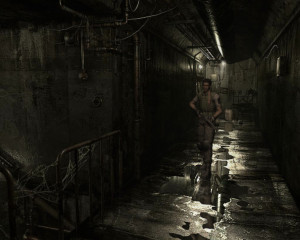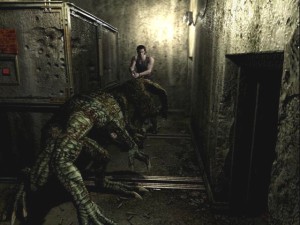
The Resident Evil remake for the Gamecube looked substantially better than other games on the system.
To challenge a person is to give them a great incentive to rise to the occasion. Throughout the videogame industry this rings true, both when games are played and when they are created. Great things are done when a worthy challenge is put forth. In terms of game development, the industry saw this in its early days up to and including the prominence of the NES, where memory was limited and the ability to convey the simplest of visuals took skill. In its own right, this skill needed to be called upon again at the turn of the fifth generation of consoles when polygonal graphics and three dimensional game worlds entered the fray. New methods needed to be created, not only to allow the player to operate easily within this new world type but also to work around new hurdles like load times and low texture quality. Game development has always involved challenges to the development team, but no more so when those challenges come from severe limitations of the hardware itself. Indeed a great deal across the internet has already been said about the astonishing feats early game music composers pulled off. And to lend further credence to the creative power of limitations, look no further than the genre made popular because of it: survival horror.
To speak of survival horror is, of course, to speak of one of its preeminent entries, the Resident Evil series. First released in 1996 by Capcom and series creator Shinji Mikami, Resident Evil was a game about keeping the player guessing and never letting them get too comfortable. The original games in the series would combine a simple shooting mechanic with a heavy emphasis on puzzle solving and resource management. The story of the games, including the newer entries in the series, is a wacky mess about secret organizations and weaponized viruses. I could write a whole series of articles about that alone, but perhaps I will bore people about it another time. Resident Evil embodies the power of limitations in nearly everything it does. The famous room transitions where a door is shown slowly opening from a first person perspective was designed both to build tension and disguise load times. Though by the time the series hit the Gamecube with Resident Evil 0 and the remake, these door scenes were much less necessary. Still, it was decided to keep them in as its function of delaying seeing whats in that next room was considered valuable. Another famous aspect of most of the older entries, aside from the now particularly butt ugly Resident Evil Code: Veronica, are the pre-rendered backgrounds. For the trade off of a stationary camera, this allowed the rooms and environments of the older entries to contain much higher quality textures than most games of its time. Especially evident in the Gamecube games, this now all but dead technique lent itself well to the series. The stationary camera often gives an unsettled feeling, with a quick switch of camera angles sometimes revealing a new threat or perhaps something that looks like one. The high level of detail was also good for a game that requires examining every room for key items, scarce ammo and healing items, buttons and levers. These design choices, originally crafted by necessity to simply allow Resident Evil to work as a game also lend themselves to the atmosphere and make the series what it is.
Challenge in game development is one thing, and often something that must be revealed, but challenge in gameplay is something designed to be seen and felt. As I mentioned briefly above, the Resident Evil series greatly restricts resources like ammo or healing items. Even the ability to save requires a finite resource, the ink ribbon, first be found and then used at a typewriter. It is perhaps a point of contention, but the default control scheme also places limits and makes the characters generally less mobile and agile than in other games. Despite this, threats can and often should still be avoided to spare scarce ammo for when it is needed. When learning the ropes in the Gamecube remake of the original, I had to quickly realize that not every zombie needed to be shot or killed. While playing I slowly became more accustomed to the so called tank controls and began to appreciate that every new room was a potential threat, though many were often empty. Throughout my first experience with the game I never felt fully prepared and always teetered on the edge of being overwhelmed by the enemy. This is to say nothing of the eerily contrasting puzzles that typically secluded me from the action while I pushed book cases around and thinking that on the other side of that door were a bunch of mutations ready to keep me from using the fruits of my puzzle solving. The challenge presented by the older games in the series is often great, especially for the first time, but I found it only made me work harder to meet it.

Resident Evil 0 managed to improve upon the pre-rendered backgrounds and is one of the best examples of it to date.
As the series moved on, series creator Shinji Mikami voiced tiredness in the formulaic nature of the games that had become evident in what would be the last of the old style games, Resident Evil 0. And so, after much ado, Resident Evil 4 was born. To be brief, this game took the series in a much more action oriented direction in an attempt to breathe new life and bring new attention to the series. And that it did. The masterfully crafted title would be a hit and also Mikami’s last Resident Evil game. From there, with the winds of popularity to its back, the series had a new console generation and much more money to play around with. And from all of this opportunity and all of this freedom came what was at the time the greatest disappointment in the mainline series. Resident Evil 5 took what 4 did and cranked the action all the way up to Boulder-Smash. The already wearisome Quick Time Events, which 4 regrettably popularized, had now become even more commonplace. What pacing 4 had preserved from the older entries to build tension was broken by a constant influx of enemies and the addition of a mandatory AI/Co-Op partner. Unlike Resident Evil 0, which had a swappable AI partner around mostly to help with inventory management and to be used in solving clever two person puzzles, this partners function was to help open those pesky doors only two people can open and to get boosted up to things. If 4 made the series more action oriented, then 5 simply turned it into an action game. Having not played Resident Evil 6 I cannot make much comment aside from it having three characters with disjointed campaigns. Likely because development included three disjointed teams, because coordinating all of them together would have been too difficult. So, following a disappointment, the response to was to throw a bigger development team and even more money at 6. The results should have been obvious.
The newer entries in the series all had great freedom before them to craft huge worlds, fully rendered and explorable. They had access to hardware that let them display many enemies and in good detail. Yet only one of the newer titles showed any discipline in its design or restraint at all and it came from the same man who worked under those old limitations of the past. The man who kept the spirit of those limitations alive despite having the resources not to. Today game development is mostly limited by finance and a person with a clear vision for the game. It is past the days when developers are given no choice but to work within the crippling confines of the hardware, making choices like dropping a sound channel in the music to make room for a sound effect. When given very little, people will try find the very best they can do with what they are given. When given the world, people tend to make a mess.